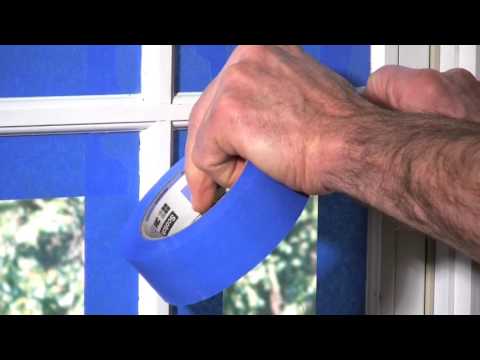Chicago Painting FAQS – How Do You Tape a Window?
In the world of home improvement and maintenance, there are countless tasks that require attention and care. One such task that often goes overlooked is taping a window.
In this informative article, we will guide you through the steps of properly taping a window to ensure its longevity and structural integrity. Presented in a simple and easy-to-follow manner, this article aims to serve as a comprehensive guide for homeowners and handymen alike.
To provide further insight into this topic, the article features a video by Family Handyman, a trusted resource in the field of home improvement. This video serves as a valuable visual aid, highlighting key points and techniques that are crucial in achieving a successful result.
Additionally, for those residing in the Chicago area, we introduce A Clean Look, a reputable handyman and paint contractor, offering their expertise and services for all your home improvement needs. With a simple phone call, you can request a free estimate at 773-419-1718.
So, whether you are experiencing a window mishap or simply looking to enhance the appearance of your home, let us guide you through the process of taping a window, ensuring a professional and long-lasting outcome.

Materials Needed
To tape a window, you will need two main materials: window tape and scissors. These items are essential for preparing and securing the tape onto the window.
The window tape is a durable and adhesive tape specifically designed for this task. It provides a strong bond and ensures that the taped area remains sealed and secure. The scissors are necessary to cut the tape into the appropriate lengths and shapes.
Before starting the process, make sure you have these materials handy to ensure a smooth and efficient window taping experience.
Preparing the Window
Before applying the tape, it is crucial to prepare the window properly. This step involves cleaning the window and removing any obstructions that may hinder the adhesion of the tape.
Start by cleaning the window surface to remove any dirt, dust, or grime. This can be done using a non-abrasive window cleaner and a lint-free cloth. Ensure that the window is dry before proceeding to the next step.
Next, inspect the window for any obstructions such as loose paint, caulking, or debris. These can interfere with the tape’s ability to adhere properly. Remove any such obstructions using a scraper or a utility knife, being careful not to damage the window frame.
By taking the time to clean and remove obstructions, you are laying the foundation for a successful window taping project.

Measuring and Cutting the Tape
To effectively tape a window, you need to measure the length of the window accurately and cut the tape into appropriate strips that fit along the edges.
Start by measuring the length of the window using a measuring tape. Measure each side individually to ensure accuracy. Add a few inches to each measurement to account for any overlap and ensure full coverage.
Once you have the measurements, take the window tape and use the scissors to cut it into strips of the appropriate length. Remember to always cut slightly longer strips to account for any adjustments needed during the application process.
Having the tape measured and cut beforehand will make the application process much smoother and more efficient.
Applying the Tape
Now it’s time to apply the window tape to the window. This step involves starting at one corner and extending the tape along the edges of the window.
Begin by positioning the tape at one corner of the window. Ensure that it aligns with the edge of the glass or the window frame, depending on your preference. Press down firmly to secure the initial end of the tape in place.
From the starting point, continue to extend the tape along the edges of the window. Make sure it remains parallel to the edge and follows the contour of the window. Apply a steady and even amount of pressure while doing so to ensure proper adhesion.
Continue this process until all sides of the window are covered with the tape, creating a secure seal.
Creating a Grid
To maximize the strength and stability of the tape, it is advisable to create a grid-like pattern on the window. This pattern helps distribute the force evenly and provides additional support.
Start by applying horizontal strips of tape across the window. These strips should be parallel to the top and bottom edges. Space them evenly and ensure they are securely pressed onto the surface.
Once the horizontal strips are applied, proceed to apply vertical strips of tape across the window. These strips should be parallel to the sides of the window, intersecting with the horizontal strips. Again, space them evenly and ensure they adhere securely.
By creating this grid pattern, you enhance the tape’s ability to withstand pressure and prevent any potential damage or breakage.

Adding Strength
To further reinforce the window tape, it is recommended to apply diagonal strips along with reinforcing tape.
Begin by applying diagonal strips of tape across the window. These strips should form an “X” pattern, intersecting at the center of the window. Place them diagonally from one corner to the opposite corner and ensure they are securely pressed onto the surface.
After applying the diagonal strips, use reinforcing tape to cover the edges and corners of the window. This tape is specifically designed to provide additional strength and durability. Apply it along the edges and corners, overlapping with the existing tape for added protection.
By incorporating these additional measures, you are enhancing the tape’s ability to withstand external forces and maintain the integrity of the window.
Sealing the Edges
To ensure a complete and secure seal, it is vital to press down firmly on the tape and smooth out any air bubbles that may have formed during the application process.
Starting from one corner, press down firmly on the tape, working your way along each side of the window. Apply enough pressure to ensure the tape adheres properly to the window surface. This step is critical in providing a strong bond and preventing any gaps or loose areas.
After pressing down on the tape, carefully inspect the surface for any air bubbles. If you notice any, use your hand or a smooth object to gently smooth them out. This will ensure a smooth and seamless appearance while maintaining the tape’s functionality.
Taking the time to seal the edges properly guarantees that the tape will provide the intended protection and prevent any unwanted air or moisture infiltration.
Testing the Tape
Before considering the window taping process complete, it is essential to perform a tug test and thoroughly inspect the tape for any gaps or loose areas.
To conduct a tug test, gently pull on the tape along each side of the window. Apply slight pressure to ensure the tape remains securely in place. If any section of the tape feels loose or gives way, it may indicate a need for additional reinforcement.
While performing the tug test, carefully inspect all areas of the tape for gaps or loose sections. Look for any areas where the tape may have lifted or did not adhere properly. If you identify any such areas, reinforce them by applying additional tape or pressing down firmly.
By thoroughly testing the tape, you can be confident in its strength and reliability in protecting your window.
Removing the Tape
At some point, you may need to remove the tape from your window. Whether it’s due to a change in weather or the need for maintenance, removing the tape can be done with a few simple steps.
To begin, use a hairdryer on a low or medium heat setting to warm the tape. Hold the hairdryer a few inches away from the tape and move it in a back-and-forth motion. The heat will soften the adhesive, making it easier to peel off.
Once the tape is warmed, use your fingers or a blunt tool to slowly peel off the tape. Start at one end and work your way along each side of the window. Take your time to avoid damaging the window or leaving any adhesive residue behind.
If any residue remains after removing the tape, it can be cleaned off using a mild adhesive remover or rubbing alcohol. Apply a small amount to a cloth and gently rub the residue until it comes off.
By following these steps, you can easily and safely remove the tape when the time comes.
Conclusion
Taping a window can provide added protection during extreme weather conditions or for temporary purposes. By following the steps outlined in this article, you can effectively tape your window and ensure a secure and reliable seal.
Remember to gather the necessary materials, prepare the window surface, measure and cut the tape, apply it in a grid pattern, reinforce as needed, seal the edges, test the tape’s strength, and remove it properly when necessary.
Always prioritize safety and take your time to ensure a thorough and reliable taping job. Whether you’re preparing for a storm or need a temporary solution, taping a window can be a simple yet effective way to protect your home or business.

